Programmatic Mitigation Peer Exchange | June 20, 2016
Summary

The American Association of State Highway and Transportation Officials (AASHTO) and Federal Highway Administration (FHWA) facilitated a Second Strategic Highway Research Program (SHRP2) Implementing Eco-Logical: Programmatic Mitigation Peer Exchange in San Antonio, Texas on June 20, 2016, at the AASHTO Standing Committee on the Environment meeting.
This programmatic mitigation peer exchange brought together transportation professionals from across the country to discuss and share their experiences developing and managing programmatic agreements for their agencies.
Workshop Moderators for Panel Discussions
Susan Haupt, Oregon Department of Transportation (DOT)
Kate Kurgan, AASHTO
Brian Yanchik, FHWA
Workshop Panel Participants
Kris Gade, Arizona DOT
Karen Hallberg, U.S. Fish and Wildlife Service (USFWS)
Jane Hann, Colorado DOT
David Hedeen, Georgia DOT
Darren LeBlanc, USFWS
Matt Perlik, Ohio DOT
Keith Walker, Alabama DOT
Welcome Presentation: SHRP2 Overview – Kate Kurgan, AASHTO
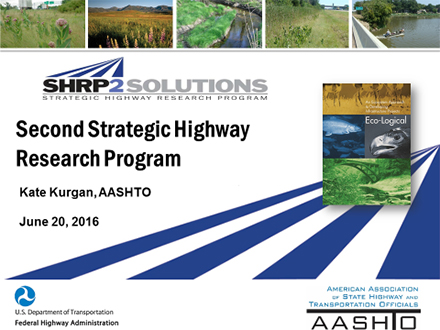
The SHRP2 Overview presentation discussed what SHRP2 is and why it is important with regards to how transportation agencies do business. Different aspects of the SHRP2 solutions were discussed, including how they were developed, field tested, and implemented and adopted as standard routine practice. SHRP2 products resulted from research in four focus areas—Safety, Reliability, Capacity, and Renewal. The goal of SHRP2 implementation is to take the SHRP2 Solutions out of research and move them into practice. Through various efforts and the six previous rounds of the Implementation Assistance Program (IAP), more than $122 million in funding assistance has been distributed to 98 entities including DOTs, Metropolitan Planning Organizations (MPOs), local agencies, and universities, as well as Federal and tribal agencies. The research led to 63 implementable solutions, and there are now 350 transportation projects underway utilizing SHRP2 products nationwide.
A presentation PDF file is available upon request.
Please contact David Williams.
Presentation: Benefits of Programmatic Mitigation – Brian Yanchik, FHWA
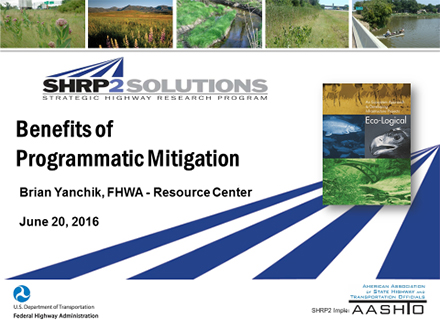
The process behind the Eco-Logical approach to developing infrastructure projects was presented. The main part of the process that was discussed was “developing agreements.” The benefits gained from implementing a programmatic approach are predictability, time savings, cost savings, and effective mitigation. The challenges that may be experienced from implementing programmatic approach are competing resources, interagency agreements, funding, and the amount of upfront work required.
More information on this topic can be found at the FHWA Review Toolkit website.
A presentation PDF file is available upon request.
Please contact David Williams.
Presentation: Lynx In-Lieu Fee Mitigation – Jane Haan, Colorado DOT
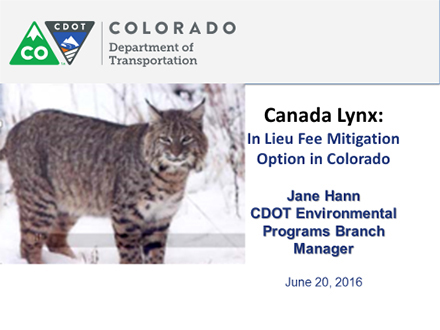
Jann Hann of Colorado DOT discussed a mitigation option that is helping Colorado DOT address impacts to the Canada lynx. The model presented may be useful for other types of mitigations.
In Nov, 2010, FHWA held the first Every Day Counts Summit in Colorado where the use of In-lieu Fee/Banking was one of the initiatives they supported. Colorado DOT formalized a programmatic agreement in July 2015 with FHWA and USFWS to allow the use of in-lieu fee mitigation as an option to consider for lynx impacts.
Research was conducted on actual mitigation costs to come up with a ladder scale that was used to assist in calculating a project’s construction budget for mitigating a lynx habitat.
The key benefits from this programmatic agreement are:
- This agreement saves time during endangered species consultation because the mitigation action is already approved.
- This allows mitigation to be conducted for the lynx that would best benefit the species, and not be limited to the location where the impact occurs.
- No project is too small to make funding mitigation impractical anymore, and this give those non-federal projects an option for mitigating endangered lynx impacts as well.
- And finally, there is an amazing framework set up to collaborate on how best to help the lynx across its Colorado range.
A presentation PDF file is available upon request. Please contact David Williams.
Presentation: Species Mitigation and Future Opportunities – Alabama DOT Gopher Tortoise Conservation Area
– Keith Walker, Alabama DOT
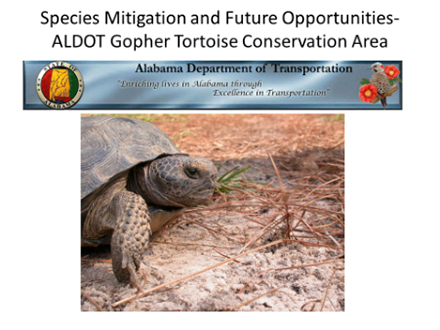
Keith Walker with Alabama DOT (ALDOT) discussed mitigation and future opportunities for the ALDOT Gopher Tortoise Conservation Area. The gopher tortoise is a federally listed threatened species in Mobile, Washington, and Choctaw Counties in Alabama. The species is listed as candidate species throughout southern Alabama, Georgia, and Florida.
A total of 12 miles of new US Highway 98 alignment traverses through gopher tortoise habitats. In 1998, a Biological Assessment found 264 tortoise burrows within the project area.
Options were evaluated to mitigate the impact to the tortoise and it was determined that the best option was to establish their own site. A 680-acre area in Chunchula, Mobile County, Alabama was established as the ALDOT Gopher Tortoise Conservation Area.
Before the new tortoises were introduced to the habitat, baseline data was collected, resident population was determined, resident tortoises were trapped, and physical data was collected. After the tortoises were introduced, their population was tracked and the habitat was maintained through prescribed burning and controlling Cogon grass.
A presentation PDF file is available upon request. Please contact David Williams.
Presentation: Rethinking the Ohio Programmatic Approach to Endangered Species Act (ESA) Section 7 Consultation – Karen Hallberg, USFWS and Matt Perlik, Ohio DOT
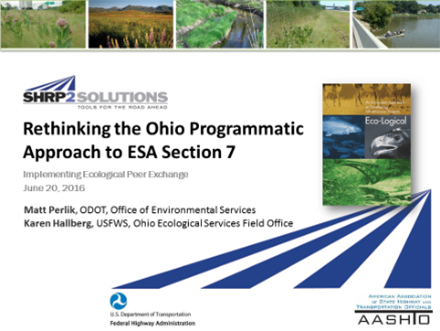
USFWS and Ohio DOT (ODOT) have implemented new and innovative strategies to deliver natural resource mitigation quickly, cost effectively, and with high value to the species. This presentation highlighted the 2007 programmatic consultation initiative on the Indiana bat, why it needed to change, and how that improvement has benefitted the agencies and the species.
In 2007, an ESA consultation on a large, complex project highlighted the need for ODOT and USFWS to develop conservation measures for the Indiana bat. With the help of mediated facilitation, programmatic consultation was established and an ODOT/FHWA-funded transportation liaison at the USFWS field office was hired.
The approach was proposed to be revised because a large number of project-specific consultations remained, definitions on terminology were unclear, and mitigation opportunities were only decided per project and not all options resulted in benefits for bat conservation. An outside facilitator from the U.S. Institute for Environmental Conflict Resolution served to help the parties develop objectives, interests, and criteria for the programmatic consultation. This resulted in a new agreement that clarified the definitions of important terms, such as roost trees and maternity trees, and established a better define consultation process (Tier 1 vs. Tier 2) to better define its predictability. As a result, consultation and mitigation requirements are better defined. And, ODOT has reduced project development time and costs. In addition, mitigation projects on the Sunday Creek Coal Company Bat Conservation Area and the Southern Ohio Veterans Memorial Highway. The latter executed as a full delivery P3 project.
Lessons learned from this process included:
- Avoiding habitat degradation or fragmentation and proactively improving habitat quality for rare and endangered plants and animals can be an efficient and effective means to species recovery.
- Working together, developing trust and understanding, culminated in meaningful conservation.
- Third party facilitator can be helpful.
A presentation PDF file is available upon request. Please contact David Williams.
Presentation: Georgia’s Indiana Bat In-Lieu Fee Mitigation Program – David Hedeen, GDOT
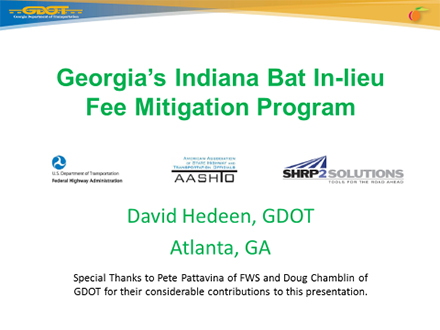
David Hadeen from the Georgia DOT (GDOT) discussed Georgia’s Indiana Bat In-lieu Fee Mitigation Program. Specifically, he reviewed how GDOT collaborated with USFWS to establish a conservation program to provide permanent forested habitat for forest-dwelling bats.
Prior to 2012, Georgia had virtually no landscape-level survey data on bats. A Copperhead Indiana Myotis Migration Study was conducted in 2011-2015 and a Northern Myotis status review was conducted in 2012. Habitat screening for potential maternity roosting areas was conducted using Hammond’s MYSO Roost Selection Model for the Blue Ridge. USFWS applied the model on a broader scale for GDOT projects. Their screening included the use of the 2011 National Land Cover Data, National Elevation Dataset, and they compared raster data to karst, captures, and winter records to determine range maps for Indiana and Northern Myotis.
After reviewing all of the data collected, a threat analysis was performed and conservation planning began. Project-level screening was conducted and conservation priorities were set and implemented and included, Use of Protection Cave Data; Development of Karst Protection Areas; and all known caves in Georgia buffered by 5 miles.
To provide more mitigation for the protection of bat habitats, an In-Kind Habitat Conservation area was set up for long-term benefit for land conservation. This included a deed restriction that stated how the land would be protected. The property was acquired in part with Georgia Bat Account in-lieu mitigation funds to provide permanent forested habitat for forest-dwelling bats in accordance with The Conservation Fund’s Memorandum of Agreement with the USFWS’s Georgia Field Office.
A presentation PDF file is available upon request. Please contact David Williams.
Panel Exchange: Ask the Panel!
Participants were asked to consider and respond to the questions below.
- How would a State DOT go about setting up an in-lieu fee program?
- What are some key factors that should be considered?
- How does the USFWS Draft Mitigation Policy relate to programmatic mitigation?
Panel Exchange: Getting the Most Out of Our Mitigation Investments – Some Creative Group Thinking
Participants were asked to consider and respond to the questions below.
- Should DOTs be in the compensatory mitigation business?
- If not us, then who?
- How can we get ahead of projects?
- How do we estimate mitigation needs?
- What drives the investments? How might states establish a conservation blueprint?
- How would states align investments with a conservation blueprint?
CHAT Update: Kris Gade, Arizona DOT – Critical Habitat Assessment Tool
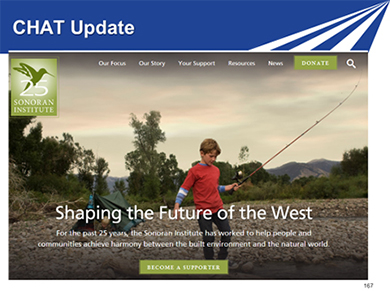
Kris Gade, Arizona DOT, provided an update on the Critical Habitat Assessment Tool and shared photos of the current website, shown here.
The Western Governors’ Association, Western Transportation Institute, and Center for Large Landscape Conservation led an effort funded by FHWA to increase the use of digital wildlife information by transportation agencies. The Western Governors in December 2013 launched a regional Crucial Habitat Assessment Tool (CHAT), an online system of maps that displays crucial wildlife habitat. In May 2015, Western Governors transitioned hosting and management of the website to the Western Association of Fish and Wildlife Agencies (WAFWA). The tool is now known as the WAFWA CHAT and is online at wafwachat.org.
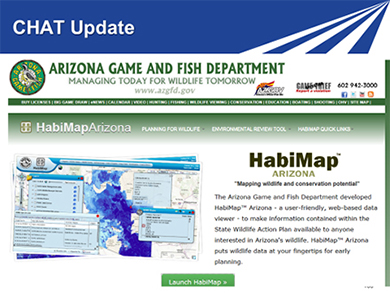
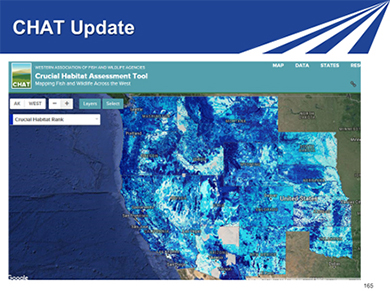
Need to request technical assistance for your Eco-Logical program? Please submit a request.

